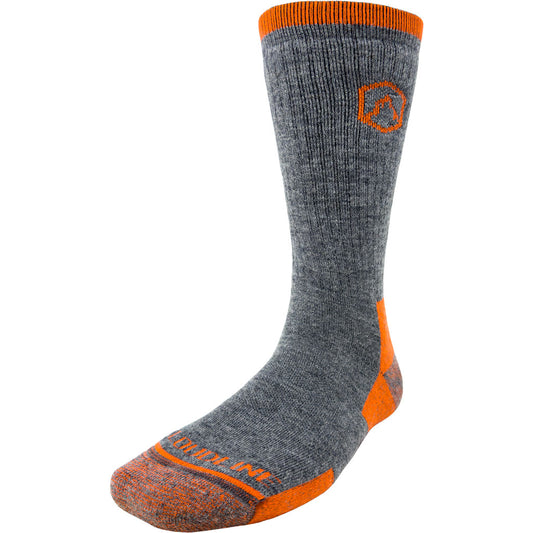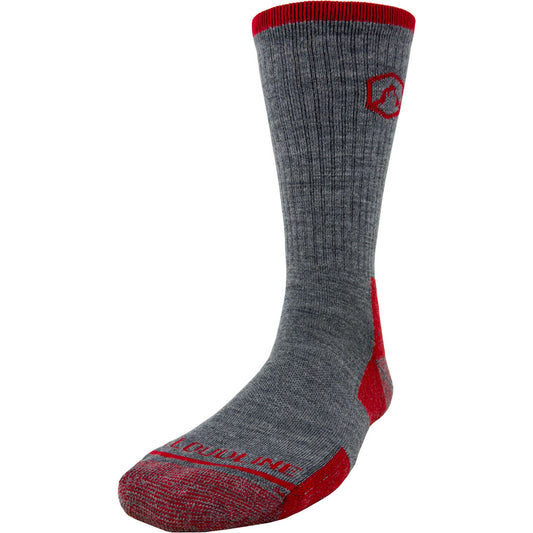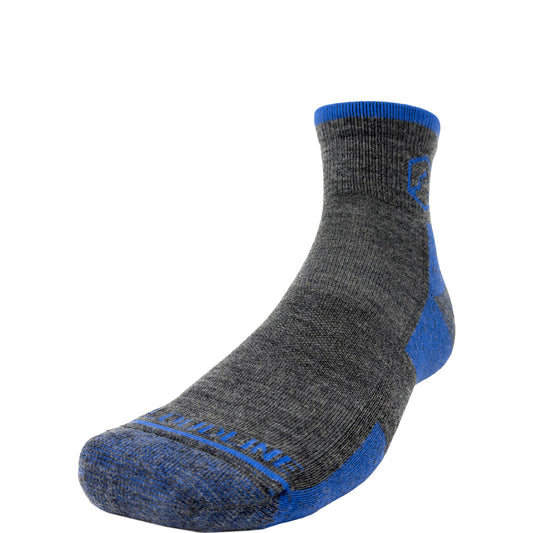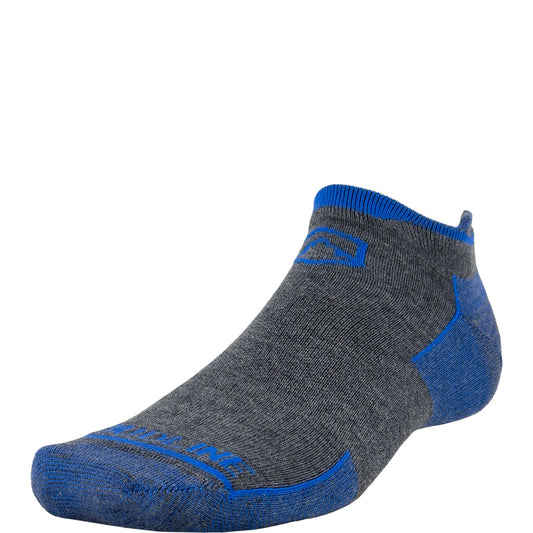
Merino Wool Compression Socks: Elevate Your Comfort and Performance
The Ultimate Guide to Merino Wool Compression Socks
If you've ever finished a long hike with aching legs or experienced uncomfortable swelling during a flight, you already understand why compression socks have gained such popularity among outdoor enthusiasts and travelers alike. But when you combine the natural benefits of merino wool with the supportive structure of compression technology, you create something truly extraordinary for your feet.
Merino wool compression socks represent the pinnacle of foot comfort for active individuals. They deliver gentle, graduated pressure that improves circulation while simultaneously providing the temperature regulation, moisture management, and natural odor resistance that merino wool is renowned for.
Whether you're scaling mountains, hitting the trail for a marathon training run, or embarking on a multi-continent adventure, the right pair of socks can make all the difference between an experience you endure and one you thoroughly enjoy. Let's explore why merino wool compression socks deserve a place in your gear collection.
What Makes Merino Wool Special?
Before diving into the compression aspects, it's important to understand what sets merino wool apart from conventional wool and synthetic materials. This isn't your grandparent's scratchy wool sweater—merino represents a quantum leap in natural fiber technology.
The Science Behind the Comfort
Merino wool comes from Merino sheep, primarily raised in the rugged highlands of New Zealand and Australia. These sheep have evolved to withstand extreme temperature fluctuations, from scorching summer days to frigid winter nights. The secret lies in the extraordinarily fine diameter of merino wool fibers—typically measuring between 15-24 microns, compared to regular wool's 40+ microns.
This microscopic fineness creates a dramatically different tactile experience. The slender fibers bend with minimal pressure against your skin, eliminating the infamous "wool itch" associated with conventional wool products. Your feet experience only luxurious softness, even during the most demanding activities.
Nature's Performance Fabric
Merino wool possesses an almost preternatural ability to regulate temperature. Each fiber features a complex structure with a hydrophilic (water-loving) interior and a hydrophobic (water-repelling) exterior. This unique composition allows merino to absorb moisture vapor from your skin before it becomes liquid sweat, then transport it outward where it can evaporate.
The result? Your feet remain dry and comfortable across a remarkable temperature range. Merino wool can absorb up to 30% of its weight in moisture while still feeling dry to the touch—a critical advantage for active pursuits where synthetic materials would leave your feet swimming in sweat.
"The performance capabilities of merino wool aren't technological innovations—they're evolutionary adaptations refined over thousands of years. We didn't invent these properties; we simply recognized their perfect application for active outdoor gear."
Perhaps most impressively, merino wool contains natural antimicrobial properties thanks to its lanolin content. This natural wax inhibits the growth of odor-causing bacteria, allowing you to wear merino wool socks for extended periods without developing the dreaded "hiker funk" that plagues synthetic alternatives.
The Compression Advantage
Compression technology has roots in medical applications but has found an enthusiastic audience among athletes and adventurers seeking performance benefits and recovery assistance. When engineered properly, compression socks deliver graduated pressure—strongest at the ankle and progressively decreasing up the leg.
Circulation Enhancement
The primary benefit of compression socks stems from their ability to improve venous return—the flow of blood back to your heart from your extremities. When you're standing or sitting for extended periods, gravity works against your circulatory system, causing blood to pool in your lower legs. This can result in swelling, fatigue, and that heavy-legged sensation many hikers experience toward the end of a long day on the trail.
Graduated compression counteracts these effects by providing external pressure that assists your veins in pushing blood upward. This enhanced circulation delivers several tangible benefits:
- Reduced swelling in feet and ankles
- Decreased sensation of heaviness or fatigue
- Improved oxygen delivery to working muscles
- Enhanced removal of metabolic waste products
For long-distance hikers tackling substantial elevation changes or runners putting in serious mileage, these circulation benefits can significantly impact comfort and performance.
Muscle Stabilization and Support
Beyond circulatory benefits, compression socks provide valuable mechanical support to muscles and tendons. The snug fit reduces muscle vibration during high-impact activities like trail running or fast hiking over uneven terrain. This diminished vibration can reduce muscle fatigue and soreness, potentially extending your endurance during challenging adventures.
The compressive structure also offers proprioceptive feedback—essentially heightening your awareness of foot position. This enhanced proprioception may improve balance and agility on technical trails, reducing your risk of ankle rolls or missteps.
Merging Technologies: Why Merino and Compression Work Together
When you combine merino wool's natural benefits with compression technology, you create a symbiotic relationship that addresses nearly every challenge active feet encounter. This isn't merely adding features—it's creating a synergistic product greater than the sum of its parts.
Temperature Regulation Excellence
Compression socks must fit snugly by design, which can potentially trap heat against your skin. Traditional compression socks made from synthetic materials often become uncomfortably warm, particularly during summer hiking or in warm climates. Merino wool's exceptional thermoregulation capabilities solve this dilemma elegantly.
The natural fiber actively transports moisture away from your skin while simultaneously allowing excess heat to dissipate. Unlike synthetics that struggle to balance compression with comfort in varying conditions, merino wool compression socks adapt to your environment. They provide warmth when temperatures drop but prevent overheating when activity levels or external temperatures rise.
All-Day Comfort For Extended Adventures
Many outdoor adventures require wearing the same pair of socks for extended periods—sometimes for multiple days when backpacking or during adventure travel with minimal packing space. Merino wool's antimicrobial properties become invaluable in these scenarios, keeping your socks (and by extension, your feet) remarkably fresh even after prolonged wear.
This sustained comfort makes merino wool compression socks particularly well-suited for thru-hikers, multi-day trail runners, or travelers who need reliable performance without daily washing. The natural fiber's resilience means your socks will maintain their supportive compression and comfort even under demanding conditions.
Choosing the Right Merino Wool Compression Socks
Not all merino wool compression socks deliver equal performance. Understanding key factors will help you select pairs that provide optimal benefits for your specific activities and needs.
Compression Levels Demystified
Compression levels are typically measured in millimeters of mercury (mmHg), reflecting the pressure exerted on your legs. For athletic and outdoor use, look for these common ranges:
| Compression Level | mmHg Range | Best For |
|---|---|---|
| Light | 8-15 mmHg | Everyday wear, travel, mild support |
| Moderate | 15-20 mmHg | Hiking, running, recovery, long travel days |
| Firm | 20-30 mmHg | Racing, intense activities, significant swelling prevention |
For most hikers and outdoor enthusiasts, moderate compression (15-20 mmHg) hits the sweet spot between noticeable benefits and all-day comfort. These socks provide substantial circulation enhancement without feeling constrictive during extended wear.
Material Composition Considerations
Pure merino wool lacks the elasticity required for true compression garments. For this reason, quality merino wool compression socks typically blend merino with small amounts of synthetic fibers like nylon, elastane, or spandex to achieve the necessary structure and rebound properties.
Look for products with the highest possible merino content (ideally 50-70%) balanced with just enough synthetic material to maintain compression integrity. This combination preserves merino's natural benefits while ensuring the socks deliver consistent pressure throughout their lifespan.
The merino fiber quality matters significantly as well. Premium socks utilize superfine merino (18.5 microns or less) for exceptional softness against your skin. This extra refinement is particularly noticeable during high-output activities where coarser fibers might cause friction or discomfort.
Performance Benefits for Specific Activities
Merino wool compression socks offer targeted advantages for various outdoor pursuits. Understanding these activity-specific benefits helps clarify why they're worth the investment for serious outdoor enthusiasts.
Hiking and Backpacking
For hikers and backpackers, merino wool compression socks excel in moisture management across varying terrain and weather conditions. The natural temperature regulation prevents overheating during strenuous uphill sections while maintaining warmth during rest periods or weather changes.
The graduated compression reduces leg fatigue during long descents, when downhill forces place exceptional stress on your lower extremities. Many hikers report significant reductions in post-hike soreness and swelling when using properly fitted compression socks, particularly during multi-day adventures with limited recovery time.
The added support also helps minimize friction inside boots, potentially reducing blister formation—the bane of many hiking experiences. When combined with merino's exceptional softness, this creates an optimal environment for blister prevention during high-mileage days.
Running and Trail Running
Runners benefit from merino wool compression socks' ability to maintain comfort across temperature fluctuations. Whether you're starting a pre-dawn run in cool conditions or pushing through midday heat, the adaptive temperature regulation keeps your feet at optimal comfort.
The muscle stabilization effects prove particularly valuable on technical trails, where uneven surfaces create unpredictable forces on your lower legs. The compression helps reduce muscle vibration and fatigue, potentially improving endurance during longer runs.
Recovery advantages extend beyond the run itself. Many runners wear merino wool compression socks post-activity to accelerate recovery through improved circulation. The comfortable fit makes them practical for extended wear compared to tighter recovery-specific compression garments.
Care and Maintenance
Quality merino wool compression socks represent a meaningful investment in your comfort and performance. Proper care ensures you'll enjoy their benefits for countless adventures.
Extending Lifespan Through Proper Care
Despite merino wool's natural antimicrobial properties, regular cleaning remains important for maintaining compression integrity and fiber condition. Follow these guidelines to maximize longevity:
- Machine wash in cold water on gentle cycle
- Use mild detergent free of bleach or fabric softeners
- Turn socks inside-out before washing to remove body oils and debris from interior fibers
- Air dry whenever possible, or tumble dry on low heat
- Avoid ironing, as heat can damage elastic properties essential for compression
Between washes, airing out your socks after use accelerates moisture evaporation and helps preserve their freshness during multi-day adventures. Unlike synthetic materials that quickly develop persistent odors, merino wool typically needs only brief airing to refresh between wearings.
Common Questions About Merino Wool Compression Socks
Addressing Frequent Concerns
Are merino wool compression socks too hot for summer activities?
Unlike conventional wool or synthetic compression socks, merino wool's exceptional temperature regulation prevents overheating even during warm-weather activities. The fiber's ability to transport moisture vapor away from your skin creates a natural cooling effect that makes merino suitable across seasons.
How long do merino wool compression socks typically last?
With proper care, premium merino wool compression socks should provide 300-500 miles of hiking or running before showing significant wear. The actual lifespan varies based on use intensity, care practices, and individual gait patterns. Look for brands offering lifetime guarantees for confidence in your investment.
Can people with wool allergies wear merino compression socks?
Many individuals who experience discomfort with conventional wool find they can wear merino without issue. The allergen response is often triggered by the larger, coarser fibers in traditional wool that cause mechanical irritation rather than true allergic reactions. Merino's fine fibers eliminate this mechanical irritation for most wearers.
Do I need different compression levels for different activities?
While specialized compression can optimize certain activities, most outdoor enthusiasts find that moderate compression (15-20 mmHg) provides versatile performance across hiking, running, and travel. If you're purchasing a single pair, this middle range offers the best balance of benefits for varied adventures.
Elevating Your Adventures with Merino Wool Compression
Merino wool compression socks represent more than just foot coverings—they're engineered comfort solutions that address the fundamental challenges active feet face during outdoor pursuits. By combining nature's most advanced performance fiber with targeted compression technology, these specialized socks deliver a remarkable experience that can genuinely transform your outdoor adventures.
The investment in quality merino wool compression socks pays dividends in comfort, performance, and recovery. When your feet remain comfortable and supported, you can focus on the experiences that matter—summiting that challenging peak, discovering new trails, or immersing yourself in travel adventures without distraction from foot discomfort.
For those who take their outdoor pursuits seriously, merino wool compression socks represent that rare category of gear that delivers immediately noticeable benefits from the moment you slip them on. The question isn't whether you need merino wool compression socks—it's how you've managed without them for so long.




